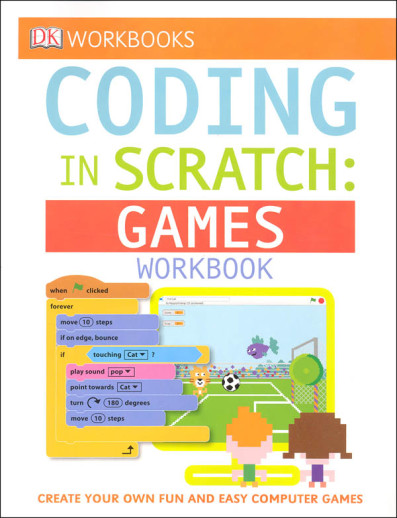We use cookies to make your experience better. To comply with the new e-Privacy directive, we need to ask for your consent to set the cookies. Learn more.
Coding in Scratch: Games Workbook (DK)
Focuses on Scratch's potential for game creation. Students create 4 game projects which incorporate sound, music, and art.
Take kids from playing games to creating them with DK Workbooks: Coding in Scratch: Games Workbook. Perfect for children ages 69 who are new to coding, this highly visual workbook is a fun introduction to Scratch, a free computer coding programming language.
With easy-to-follow directions and fun pixel art, DK Workbooks: Coding in Scratch: Games Workbook helps kids understand the basics of programming and how to create games in Scratch through fun, hands-on learning experiences. All they need is a desktop or laptop with Adobe 10.2 or later, and an internet connection to download Scratch 2.0. Coding can be done without download on https://scratch.mit.edu.
DK Workbooks: Coding in Scratch: Games Workbook helps kids make their own Scratch Cat soccer game, design a ghost hunt that features a flying witch, animate a bouncing melon, or build a game to test reaction speeds, with simple and logical instructions every step of the way. Then, they can share the finished games with friends to see how they score. Kids can even test their coding knowledge with written vocabulary and programming quizzes at the end of each project.
Supporting STEM education initiatives, computer coding teaches kids how to think creatively, work collaboratively, and reason systematically, and is quickly becoming a necessary and sought-after skill. DK's computer coding books are full of fun exercises with step-by-step guidance, making them the perfect introductory tools for building vital skills in computer programming.
These introductory-level workbooks are excellent for gauging students programming aptitude! Before you settle into a more thorough programming course or guides (such as the DK Coding Games & Projects series), this inexpensive series is good for testing the waters of potential coders. Each book begins with a 4-6 page getting started... section just enough to understand the language and interface, but nothing more. The real meat of the workbooks is 4-5 simple projects of increasing complexity. Students create a project, make a few decisions of their own, and then take a quiz to test their understanding of the chapters materials (solutions included in the back). The projects are organized into numbered paragraphs, each accompanied by a snippet of code or screenshots of what the student will be seeing. Humorous illustrations and helpful captions lighten up each page to further engage readers. Each book in the series can be used independently or together, as there is little overlapping material. Overall, this is one of the best series available to introduce very young students to programming without investing much time or money. Scratch books require Adobe 10.2 or later and use Scratch 2 (available for free online). Each book is 40 pages, paperback.
| Product Format: | Paperback |
|---|---|
| Brand: | Dorling Kindersley |
| Grades: | 2-6 |
| ISBN: | 9781465444820 |
| Length in Inches: | 11 |
| Width in Inches: | 8.5 |
| Height in Inches: | 0.125 |
| Weight in Pounds: | 0.4 |

